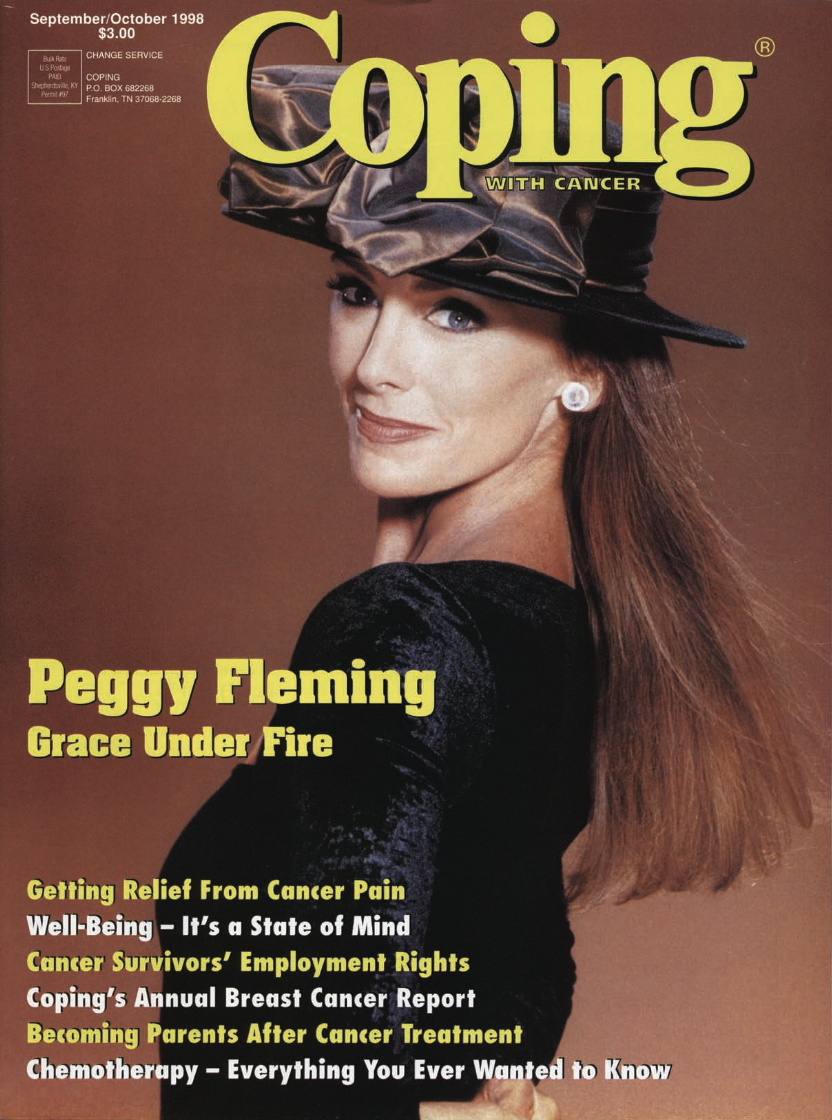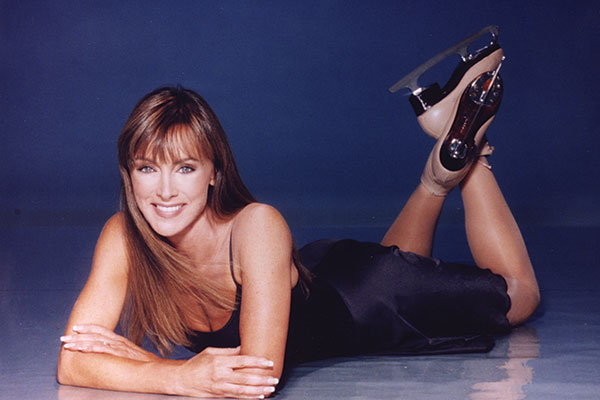Peggy Fleming
Grace Under Fire
by Cindy Phiffer
grace’ful 1. Seemingly effortless beauty of movement, form, or proportion. 2. A pleasing characteristic or quality 3. A sense of fitness or propriety 4. Good will and elegance. 5. Peggy Fleming
In the ’60s, Peggy Fleming floated onto the ice and into the hearts of a country divided by turmoil, civil unrest, and rebellion. She drew us to the TV screen to watch her spin a healing legacy at a time when rage and discontent threatened to tear America apart. Her incredible beauty and discipline embodied the freedom and responsibility that we seemed unable to balance.
Thirty years to the day after winning her gold medal in the Olympics in Grenoble, France, America gathered once again to root for its favorite champion. This time, however, the arena was an operating room.
During a self-exam a month before, Peggy had discovered a lump in her left breast. “That’s what saved me,” she says, her voice as smooth as her skating style. “I’d had a mammogram and my checkup five months earlier, and nothing showed up. I was getting ready to do some work for ABC [Television], and I was checking myself in the mirror. I saw a shadow of a lump on my chest. / don’t have one on the other side. I thought, so it’s not a matched set. Something’s a little off. I wasn’t panicked because when I was in my early 20s I had had a lump removed that was benign.”
This one, however, turned out to be malignant, sending the 49-year-old into training mode. “I wanted to know every detail,” she recalls. “I’m married to a physician. He helped me ask all the right questions. too. I got Dr. Susan Love’s Breast Book, and that was very informative with what was happening, what’s going to happen, what other kinds of cancers there are. I did not read about many of the other kinds. I just zeroed in on my own so I would not scare myself, and l just listened to my doctor, and made sure that I was doing everything I could.”
After gathering the information, Peggy and her husband, Greg Jenkins, asked for an aggressive approach. “I wanted to have peace of mind,” she says. “l needed to make sure that I’d done everything I possibly could to have this not recur later on.” For Peggy, this would mean surgery to remove the one-centimeter tubular carcinoma which was surrounded by a clear zone.
“My doctor kept telling me this was the best kind of breast cancer to have. It was the most curable one. I thought, everything is fine because I have the most curable one I can get. I wanted to have them take more tissue around the clear zone, just in case. He had to take some of the lymph nodes out just to be sure that it hadn’t traveled anywhere. Those were negative, so I have peace of mind that I’ve done everything that I possibly could.'”
Part of her treatment program included follow-up radiation. Peggy knew that this would be demanding on her family, her schedule, and her system, so she and a dear friend took a long-anticipated vacation to a spa for plenty of rest and relaxation.
“I had the tube pulled out the day before l left. I brought lots of bandages and antibiotics on the trip and I was fine. I was just fine.” Her voice slows and the determination of the woman who was ready for some time away from phones and family needs and media attention can be heard. Then, just as quickly, the firmness melts and her voice softens with the memory, “We had the most peaceful time.”
The lifelong athlete knows the importance of taking care of her mind, body, and spirit. “I took yoga. We did aerobics. We ate well. I did a lot of reading, and I had a lot of quiet time.” Apparently, the time was just what the doctor ordered. “I came back and the next morning I rolled up my sleeves. I said, ‘Okay. Let’s do radiation.’ The attitude was like, I’m gonna do this really well. I’m ready for it. Come at me.” When asked if that was the competitor in her, a grin warms her voice, “I guess it’s really in my blood.”
For the following six weeks, Peggy Fleming would start each weekday with radiation. “I had my radiation early in the morning, and then sort of forgot about it all day long until the next morning. I think scheduling it that way helped me carry on my life a little more normally.”
But maintaining a routine wasn’t enough to fend off some common side effects. “I thought it was going to be real easy,” she admits, “and it is … relatively. But about two-and-a-half weeks into it, I started feeling tired, really swollen, and itchy. It really irritated my skin. I was also exercising through the treatments, and I think that made it more irritated. I had to do a little balancing act of, Okay, I won’t exercise quite that much, and I’ll use some cortisone cream to take down the itching. You compare notes with other radiation patients, and you try all kinds of things.”
Sharing information with other survivors has been critical to Peggy’s recovery. ‘Tm glad I wasn’t isolated from the other patients,” she says, “because I needed that support, too. I needed to share some of my feelings and hear theirs. There were people with all different degrees of cancer and they’ve gone through different degrees of treatments. You compare feelings. It’s helpful, no matter what level of cancer you have. You take their advice. You trust them because they’re going through it, and they’re honest.”
In June, Peggy was invited to appear at the National Cancer Survivors Day® event at the Wall of Hope in California. Although she’s obviously disappointed that her involvement in such activities has been curtailed due to her decreased stamina, she made time to show her support and invite some of the friends she’d bad radiation with. “It was fun to reminisce about our treatments,” she says, trying to suppress a chuckle as memories of the silver lining brighten her thoughts. “They had to tear us away from talking to go get our treatments. Actually, we had fun in the waiting room! Does that sound bad? We were just trying to ignore the fact that we were having these treatments, and we would just be friends. We had some good, fun conversations and shared our lives.”
The still-fit lady of the ice urges others to take their bodies seriously.
“People need to get more in charge of looking at themselves and finding out how they’re feeling,” she insists. ”If they’re feeling really different, pay attention to the changes. Early detection is a key element and a wonderful tool to save your life when it comes to cancer.”
She’s concerned that, for some, the advancement of technology and the quality of medical care may provide a false sense of security. “Mammograms and doctors are not fool-proof,” she reminds us. “These are just some of the tools that we can use for early detection. We are the best tools. We know our bodies better than anybody.”
Ironically, it may have been this very confidence and a healthy lifestyle which allowed cancer to take Peggy by surprise. “I was doing everything I could to keep healthy,” she says, and you can still hear the disbelief in her voice. “I do my regular checkups. I eat right. I exercise. I really do pay attention to my body and my health, so I thought, Why does this stuff happen to me?” Then, answering her own question, she says, “I thought, Maybe it’ll help other people who think it can’t happen to them because they’re doing all the right things.“
In classic Fleming fashion, she never gave these questions a chance to take over her thoughts. “I think if you always think positive, more positive things will happen,” she explains. “It’s like when you compete at a championship. If you go out to start a competition with the attitude in your head of like, Oh, my gosh, I hope I don’t fall on that. you’re gonna fall on that! But if you go out there with a positive attitude like, Okay. I am going to do the best I possibly can and I’II just think of all the good thoughts that I’ve learned over the years, you can put it all to work. Those were the feelings that I approached my treatment with. I wanted to be the best patient my doctor ever had. I wanted to make him proud. I wanted to make myself proud. I wanted to do the best that I could.”
Peggy Fleming will leave the world of figure skating forever changed. She looks at cancer as a sign that it was time to focus her energy closer to home. “I needed to slow down a bit,” she says, “and this definitely slowed me down. A goal of mine, even before my cancer, was to make more time for my family and not make everything absolutely perfect. I’ll catch myself getting uptight and I’ll say, ‘Okay, enjoy this day. I’m healthy. I have a beautiful family. We’ll get dinner on the table … eventually, I’ll get this house straightened up … eventually!”‘
Even as she says the words, her voice belies the struggle she has accepting anything less than a perfect 10. She needn’t worry. Her biggest fans live in the same house with her. She says that during her most difficult days during recovery, she surrounded herself with immediate family, including her husband Greg and her sons Todd and Andy, and kept very quiet. “It really centered me. I got lots of love from all my boys,” she says, “especially my husband. He’s the best.”
Who could imagine less for the woman who planted seeds of renewed pride in our country? Through her own survival, Peggy Fleming continues to nurture our sense of hope by living like she skates … like grace under fire.

This article was published in Coping® with Cancer magazine, September/October 1998.


